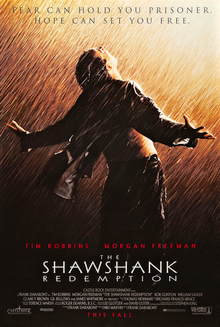
The Shawshank Redemption has enjoyed quite a popular revival in the years since its 1994 release. It opened initially to mediocre box office, and was largely ignored in a year dominated by Forrest Gump and Pulp Fiction. Ironically, it has now gained status as a modern classic, and currently sits in the number one position on IMDb's Top 250, which ranks the public's highest-rated films. Yes, according to thousands of voters, The Shawshank Redemption is the greatest film of all time. I find it absurd to think any such thing exists, and even more absurd to think that this film tops the likes of The Godfather, Citizen Kane, Casablanca, and countless others. Still, all hyperbole aside, The Shawshank Redemption is a beautifully constructed and inspiring piece of entertainment.
The story concerns Andy Dufresne (Tim Robbins), a mild-mannered banker who is convicted on circumstantial evidence of killing his wife and her lover. He is then sent to Shawshank Prison for two life sentences. Andy makes friends with Red (Morgan Freeman), an inmate who is known throughout the prison as the man who "knows how to get things." The film chronicles 20 years in Andy's life, depicting the friendships that form between the prisoners and the corruption of the prison system.
From the very beginning, The Shawshank Redemption presents a very intimate portrayal of prison life. Almost the entire film is set within the walls of Shawshank, and over the course of the story’s two decades, we begin to understand the characters and their traditions. During the first scene at the prison, we jump in on the middle of such a tradition. As the convicts watch the new arrivals shuffle in from a bus, they place bets on who will be the first to break down crying. Red bets on Andy. There is a certain macabre formality about that scene. We realize that the inmates have seen bus after bus pull in to Shawshank over the years, knowing full well that prison will break some men.
But much to Red’s disappointment, it does not break Andy, who remains silent all through his first night. Andy soon emerges as something of an oddity at Shawshank. His walk is a carefree stroll, and he does not seem to be terribly perturbed to be in prison (although it is quickly established that he is innocent). Robbins plays the character as something of an enigma; he talks rarely, and we never fully understand him. Yet he quickly earns the respect of everyone at the prison – even the warden (Bob Gunton), who enlists Andy to handle prison finances.
Red, Morgan Freeman’s character, is the other primary protagonist of the film. Freeman is as always a likable actor, but he may be too likable here. After all, Red is a convicted murderer, but like many of the other prisoners, we never see that side of his personality. This illustrates the main problem with the movie – the prison seems too nice, too friendly, too warm. There are exceptions, of course. In several scenes, Andy is raped by a gang of men, and the prison guards are always violent and nasty. But the movie is severely lacking in moral ambiguity. With few exceptions, the prisoners are all good and the guards and warden are evil.
Still, The Shawshank Redemption is rather brilliant in the way it shows the long-term effects of prison. In one scene, an old convict named Brooks (James Whitmore) is finally released on parole. He stumbles alone through 1950s America, staring at strange cars and working a menial job at a grocery store. The tragedy is that in prison, Brooks was somebody – everyone knew and respected him as the librarian. In the real world, he is just a lonely old man.
The Shawshank Redemption is also beautiful to look at, though never too showy. For the majority of the film, the color scheme is muted, and everything seems realistic. This stylistic choice seems to fit with the oppression of the prison setting. The one major exception is a triumphant moment near the end of the film, which is simply gorgeous in its imagery. I won’t describe it, as it reveals a key plot point. But it is the most memorable scene in the film, and it really exemplifies what The Shawshank Redemption is all about. A few weeks ago I wrote about Cool Hand Luke, another prison movie, saying it was “a stirring affirmation of the human spirit in the face of adversity.” The same can be said of this particular scene, and of The Shawshank Redemption in general. “I guess it comes down to a simple choice,” Andy tells Red. “Get busy livin’, or get busy dyin’.”
Verdict: A-
1 comment:
"After all, Red is a convicted murderer, but like many of the other prisoners, we never see that side of his personality."
The book goes into detail about what exactly Red did - he killed his wife by cutting her brakes. And inadvertently killed two other people to boot. One of them a kid.
The book also ends with a note about hoping to see Andy again - we don't see the reunion on the beach.
Post a Comment